The wines of Jerez offer unexpected chords.
Agreements that work surprisingly well with many dishes that are usually reluctant to be accompanied by a classic white or red wine.
However, they are often relegated to the rank of aperitif wines where they stagnate totally forgotten by the consumer who ends up denigrating them.
The proposed weddings show that the 'Vinas Generosos' as they say there can shine from aperitif to dessert without forgetting the appetizers, the dishes and the cheese.

WINE AGREEMENTS FROM ANDALUSIA AND BELGIAN SPECIALTIES
RESTAURANT AT LEON
o Aperitif: mini mold croquette
+ Manzanilla Papirusa from Lustau and Manzanilla Argüeso
o Entry: gray shrimp croquette
+ Amontillado Colosia andAmontillado Aurora
o Entry: sea mussel
+ Manzanilla Solear Barbadillo and Fino Colosia
o Flat: American
+ Oloroso Colosia and Palo Cortado Lustau
o Cheeses:
Manzanilla San Leon and Ximenez-Spinola Old Harvest
o Dessert: crêpe Léon flambé tangerine napoleon
Eva Cream Bardadillo and East India Lustau
As an aperitif : Some mini mold croquettes come to tickle the Manzanilla
of Argüezo and Papirusa of Lustau
Manzanilla of Argüezo
The white robe with light golden hues enchants with its nose of hazelnut, green nuts and grated apple powdered with a little white pepper, with its iodized accent.
The almost dry mouth almost immediately refreshes the taste buds, sharpens them, makes them attentive to what will follow.
The beautiful length with its saline note reminds the spray of the near ocean.
Lively and fresh, befits an aperitif.
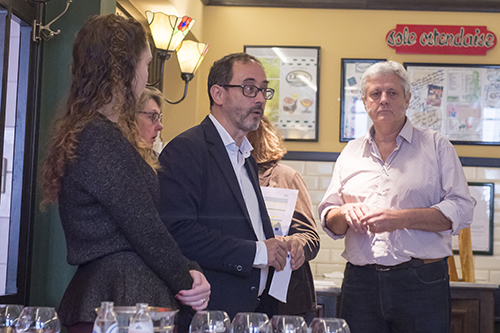
Manzanilla Papirusa from Lustau
The bright white robe is fragrant with hazelnut and grilled pistachio and glides towards the scents of lemon and chopped celery.
Then go back to the almond, the raisins, with a hint of fenugreek.
The fresh mouth with rounded curve is highlighted by a salty line that decorates the palate with some dried seaweed.
Marine condiment with pepper, nutmeg and cumin.
The lemon incises the taste buds to further sharpen the palatability of the manzanilla.
The agreement
The Manzanilla prance on both fried coatings, revives the shell that was hidden behind the crust of bread crumbs, plays with lemon and a nose to the mayonnaise which contrary to what one would have thought, adds roundness at the wedding.
There does not stop their assets!
Their aromatic richness finds a response both within the crisp flesh.
New tastes arise, gourmet fusion, racy mixtures, sea and land.
Ultimate advantage, the Manzanilla leave the mouth clear once the bite swallowed.
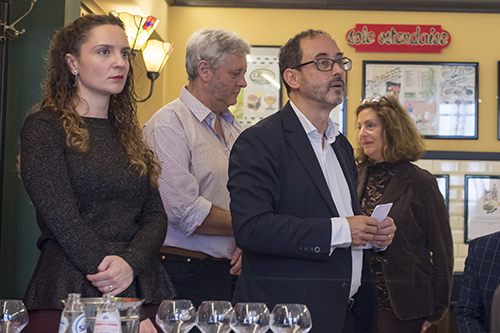
First entry:
A gray shrimp croquette teases the Amontillado Colosia and
Aurora Yuste
Amontillado Colosia
It has the color of wet tobacco, shining like brown amber with greenish transparency.
The roasted nose recalls the charm that burns in the hearth, the nuts nibbled around the fire, the salt of the spray, the warming stone, the caramel of the autumn afternoons, the tea lapsang suong tasted in sips.
The charm breaks in the mouth.
The taste buds expected to cocoon, they are surprised by the vivacity, the drought of the character and the strength of the spirit.
Provocative, this violent hidalgo of spices, iodine and licorice, slips on it to better imprison them in the subtle gangue of its complexity.
In an instant, they are subjected to this beautiful lover.
The agreement
Intense, the wine seems to grill the shrimp, plancha iodine and salty which admits without reservation its greediness, its peppered character, its vivacity supported.
The superb length evokes the freshness of the lemon that has been confit, reinforces the delicate aromas of the bisque and the sweet impression given by the device.
Amontillado Aurora Yuste
Dark brown amber, a nose like a red iron that sinks into the mass of an oak log, then dry mushroom, leather, red tea, then
spices, iodine, licorice wood and a shortbread biscuit.
The palate is salty and salty, with great freshness, great elegance and breathtaking length, reminiscent of salted caramel, walnut, hazelnut and almond.
The agreement
An agreement in contrast in which the marriage is not consumed right away.
The partners look at each other, wait a moment before marrying.
A magnificent maelstrom is born which mixes sugar and salt, spices and marine flavors.
The pleasant bitterness of the almonds sinks into the flesh of the shrimps, an impression of gingerbread with orange blossom springs forth, then returns the marine fury which is accustomed to the earthly lukewarmness.
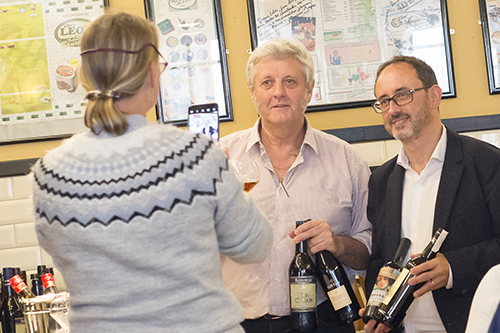 Second entry: The mussels meet the Manzanilla Barbadillo and the Fino Colosia Second entry: The mussels meet the Manzanilla Barbadillo and the Fino Colosia
Manzanilla Solear Barbadillo
The white dress with light green hints of flaked almonds, green nuts, fresh celery, fenugreek with a hint of blond tobacco.
On the palate, the pleasant bitterness of the kernel details the fat of the nut, refreshes with citrus zest.
Then, go on impressions of dry stone with a hint of salt, brioche with orange blossom, all refreshes of a lemon juice and softened with a drop of caramel.
The length on salt and spice makes us even more salivate.
The agreement
The Manzanilla recognizes at first the iodized development, salty spray, the taste of vegetables, the spicy.
Suddenly, the Andalusian is transformed from sea to sea, brings a floral and fruity volume to the bivalves, the ax in small pieces to present it to the taste buds alerted.
It reigns in the palace a nutty atmosphere, a spicy atmosphere, the molds are sublimated and seem to offer more, both fat and tense, both gourmet and austere, a series of contrasts that makes the wedding haunting.
Fino Colosia
A dress of a bright white moiré of golden reflections, it is of circumstance!
The nose is flavored with hazelnut and green nuts, then slips the more acid scents of grated apple and chopped celery leaves.
The fat mouth and fresh, really round for a manzanille, gives incredible oral comfort.
The beautiful length relieved of a saline note reminiscent of iodine, ends with taste the pleasure taken.
A lively and fresh Manzanilla as it should!
The agreement
A very elegant agreement!
The popular dish becomes a starry dish, offering a number of delicate notes that evoke iodine, salt spray, seaweed.
But also a procession of terrestrial impressions of aromatics and damp earth.
In short, here is a talkative marriage that can not help but talk about hazelnut and turmeric, celery and bay leaves, but always with the greatest delicacy.
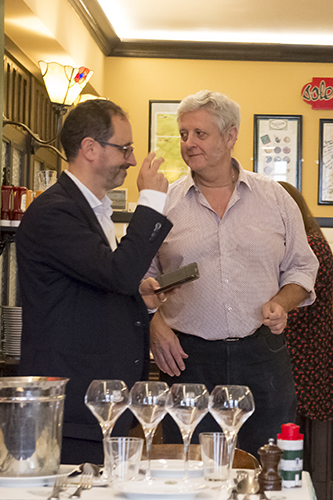 The dish: When an American lands in the middle of an Oloroso Colosia and a Palo Cortado Peninsula Lustau The dish: When an American lands in the middle of an Oloroso Colosia and a Palo Cortado Peninsula Lustau
Oloroso Colosia
Chamois amber tinged with brown, the nose grilled like a bouquet of dried flowers thrown on a hot limestone of sun, it flows an unsweetened caramel with salted butter.
The syrups of taped apples escape from it, curls of brown tobacco color the perfumes, pasta of prunes round the mouth on the end.
The agreement
A rather sweet accord that likes the salty vegetal notes of capers that revive the debate on the mineral of wine. The sweetness of the raw onions and the tang of Tabasco calms, then ignites the Oloroso which at the same time gives notes of caramel and iodine, walnut paste and seaweed, for a time to make us think of an alliance earth- sea.
Palo Cortado Peninsula Lustau
The brown coat with green hues and a discreet nose that sparingly distils notes of candy, brown sugar, molasses and burnt caramel.
Age has sharpened his mind.
Facetious, he likes to joke today.
Of course, it is anything but sweet!
The size and volume of its structure might imply it.
But here it is heady and glycerol whose suave viscosity traps in its gangue pepper, cinnamon, cardamom, grilled hazelnut, splinters patinated wood, licorice stick, a thousand spices and then candied citrus fruits that generate a welcome freshness.
He is a lord, a wise man who knows more about us than us about him. Welcome him without fear, he likes to lavish what he has learned.
The agreement
He seems wise, as if completely satisfied, without any other expectation than these few
sweet spices, condiment ratio.
Then, all of a sudden, plant liqueurs burst on all sides with dried celery, sage, thyme, pepper, underlined with a fresh, bitter and sweet note of candied citrus fruits.
The cheese plate:
When the cheeses appear, Manzanilla San Leon and Medium Ximenez-Spinola salera 1964 bow
Manzanilla San Leon
Pale yellow with green hues, it smells candied lemon, the shortbread biscuit burnt starry starred celery salt.
The mouth seems heavy and invasive at first sip.
But the palate that combines salt and pepper, turmeric and fenugreek, dry flower and dry fruit quickly belies the initial impression.
It is in the mouth length that the wine expresses itself the most, iodine, aromatic herbs, seaweed, bitter noble.
A Manzanilla of a more difficult approach, which must be penetrated to understand it well.
The agreements
With fresh goat cheese
The accord develops pleasant notes of nuts, almonds, nuts, sublimated by the iodine character of the wine, which makes the cheese more mature.
Fresh is almost refined offering a surprising mocha cream.
With the Maredsous
An exchange land sea where we find humus and wet land strong scents like after the storm that mix with a bouquet of seaweed.
With Herve AOP
The salty notes of one and the other, like the tangy, agree to develop pleasant bitterness reminiscent of coffee and caramel a little burned.
With Roquefort
The blue is surprised by this marriage proposal, certainly unexpected but
quickly leads to flavors of vanilla cream and chestnut cream with the spices of both partners.
Mediu Ximenez-Spinola salera 1964
Light brown, a nose of iodine, wood that warms, pine paneling, it's like in the hollow of a cottage in the Landes seaside in winter.
The nice fat in the mouth we install even more comfortably in this winter atmosphere.
And encourages us to continue tasting in the best conditions.
We finish with almond, walnut and a subtle taste of caramel which rounds and dampens by its sweet note the heady character of the wine.
A wine of great comfort.
With fresh goat cheese
A creamy cream immediately deploys its nuances of pistachio paste slightly caramelized with a dash of iodine that tickle the ambient sweetness.
With the Maredsous
An easy wedding where everything rolls without breaking your head while enjoying the pepper that raises the cream of brown.
With Herve AOP
The wine accentuates a moment the strong taste of the Herve, highlights its white chocolate side, peanut and creme brulee, then the sweetness transforms the cheese into real gourmet dessert, pear cream with well peppered coffee.
With Roquefort
A mouth full of freshness, the cheese erases the sweetness of the wine and distils its mineral aromas to finish on a bouquet of spices.
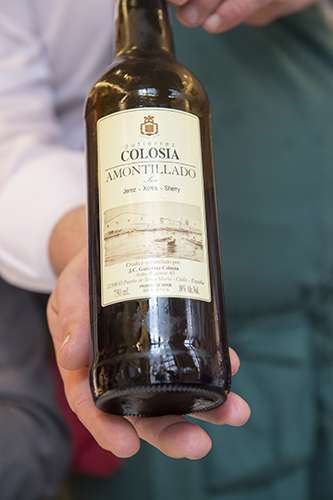
Dessert : The Léon crepe flambé with the mandarin Napoleon captivates / 'Eva
Cream Bardadillo and East lndia Lustau
Eva Cream Bardadillo
Dark amber where the nose quickly discerns an iodized note like that exhaled by a slice of sardine.
Then come the sweet perfumes of candy, brown sugar, mashed chestnuts and currants.
Raisin makes the transition from dried fruits, dried nuts and toasted almonds.
Finally, nutmeg and brown tobacco encourage
mouth to soak his lips in this nectar of the sweetest.
But, surprise!
This cream is incredibly light.
The important sugar is hardly invasive and its crisp lighten its richness. The equilibrium is definitively acquired from the perception of a grain of coarse salt that seems to be born from sea spray.
This sweet dessert is quickly stripped with a stroke of Eva Cream that takes as much for its sugar.
This allows to continue on very refined bitters that come to refresh the palate while developing aromas of candied citrus peel underlined cinchona.
East lndia Lustau
The red amber of her dress reflects some golden hues.
As for scents, would they come from the east charged with sweet and spicy spices, rare essences, pepper from the Malabar coast?
Can we drink it, is it not too much pleasure in one glass?
From the first sip, we are transported.
Almonds, dried figs and black olives lead us from Hispania to the Asian border populated with sweet scents.
Suave, it flows on the tongue that sizzles savoring the candied orange, the tip of the mocha, the freshness of the lemon.
It's almost too much, close our eyes and let our taste buds enjoy.
We would be afraid to see the sweets accumulate, but surprisingly, they cancel each other to leave us fresh mouth and populated with spices.
This freshness reminds us of the ocean and its smell of iodine that bring us from far away a mixture of turmeric, fenugreek and jasmine.
When citrus fruits, they prefer to leave us their candied bitters as a souvenir than their sweetness. A gourmet and elegant finale.
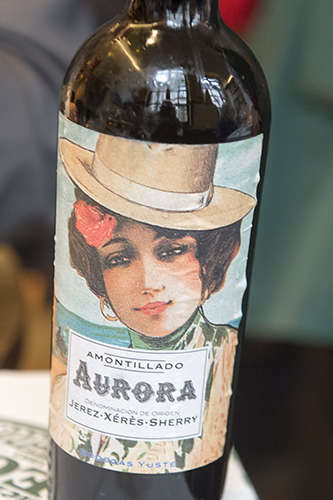 Production of Vinos Generosos Production of Vinos Generosos
In the magic triangle of southern Andalusia, there are plenty of houses that, behind the walls of a white past, raise their wines of Jerez.
Sanlucar, Jerez or Santa Maria are home to well known, less known and unknown wineries.
At Montilla Moriles, the same things happen, except that the varietal used is not the same.
Palomino Fino in Jerez and Pedro Ximenes in Montilla.
Fino and Oloroso, the two great families of Jerez
Amontillado, Palo Cortado, Cream, Manzanilla and company seem to speak a complicated language.
Here is an attempt to explain ... simple.
A clearing that will leave, I hope, the amateur free spirit to enjoy all these wonders without wondering who is who. i Perdoname, no understand!
Classification of Jerez
The moment of the harvest
Palomino fino grapes are harvested from mid-September.
A manual harvest and as fast as possible to avoid the risk of oxidation of the berries, exposed to a daily temperature of 45 ° C.
The minimum required is 10.5 °, yields are around 75 hl / ha for a planting density of 3,500 to 3,800 vines / ha.
Vinification
The classification
Around the month of December, a tasting leads the unclarified wines, towards the type Fino or Oloroso. Each barrel is marked with chalk:
- 1 trait (raya) = a very pure, airy wine, usually derived from white marl soils (albarisa); he joins the group of Fino.
-1 trait and a point = a wine more powerful, more flesh and strength, generally coming from more clayey grounds; he leaves for the Oloroso group.
-2 and 3 traits are not suitable for making Jerez wine.
The type
The Fino family
A line gives the right to an enrichment of 15 ° to 15.5 °.
A mutage that allows the installation of the veil.
Veil that cleans the oxidation of wines.
This family is divided into a first two styles: the Manzanilla, which comes only from Sanlucar de Barrameda.
It's a finer Fino, fresher and more elegant than Fino made in Jerez and Puerto de Santa Maria.
Involved, a yeast veil installation faster, thanks to the double influence, the proximity of the Atlantic and the vicinity of the mouth of the Guadalquivir, carried by the west wind, the Poniente.
The Oloroso clan
A line and a dot enriches the wines at 17.5 °. An alcohol level that prevents the birth of any yeast veil. Oloroso therefore undergo a faster and greater oxidation than Fino.
livestock
The bota, a 600-liter American oak barrel, fills with 5/6 of its capacity. The remaining vacuum facilitates the installation of the yeast veil (flor) or precipitates the oxidation according to the type.
The solera
This recent breeding technique (it goes back to the second third of the 198th century), homogenizes the production of the cellars. There is no vintage effect, nor any "terroir" effect, but rather a vertiginous dive into the world of quality oxidative wines.
The continuous fractionation.
The barrels are stacked on three heights, even four.
Each floor is called esca / a.
The row of soil is called salera (Spanish suelo, soil).
It contains the wine, or rather the wine blend, the oldest.
It is from her that we will draw (sacar) the wine bottled, up to. or 1/3 of the volume of the bota.
This measure is replaced by an equivalent quantity transferred from the floor above, a criadera (criar, raise).
The wine drawn from the first is replaced by that of the second and so on. This operation is called the bullfight of escalas (the progress chart).
The ultimate criadera receives the wine of the year.
The Manzanillas and Finos keep the veil for at least three years.
When the flor diminishes, Manzanillas and Finos pass through the stadium of Manzanilla Pasada and Fino Amontillado.
When the veil finally disappears, they become both full-fledged Amontillados.
Breeding, this time totally oxidative, will continue or not according to the opinion of the cellar master.
A rarity
Once, when oenological techniques were stammering or nonexistent, the initial classification sometimes resulted in unexpected results: there was from time to time an Amontillado barrel with the corpulence of an Oloroso.
The cellar master ("capataz", for intimates), then affixed a particular mark: a stick cut off a bar, the palo cortado.
This intermediate product with a particular taste is still found today, but from old barrels.
* We will speak preferably of a geographical indication, because it is here and there only that this type of wine is produced.
Otros vinos
The Jerez vineyard also produces two sweet wines, the Pedro Ximenes and the
Moscatel.
They are both vinified after passerillage (soleo).
Highly concentrated musts only partially ferment their sugar and enjoy salt farming or not. They carry the extra denomination of Vino Dulce Natural when bottled alone.
The Pedro Ximenez brings its very sweet note in various assemblages called Vinos Generosos de Liquor (the Vinas Generosos 'tout court' are dry). Sliding to the increasingly sweet Jerez depends on the rate of added PX, Medium, Cream and Company. |



 Second entry: The mussels meet the Manzanilla Barbadillo and the Fino Colosia
Second entry: The mussels meet the Manzanilla Barbadillo and the Fino Colosia The dish:
The dish: 
 Production of Vinos Generosos
Production of Vinos Generosos